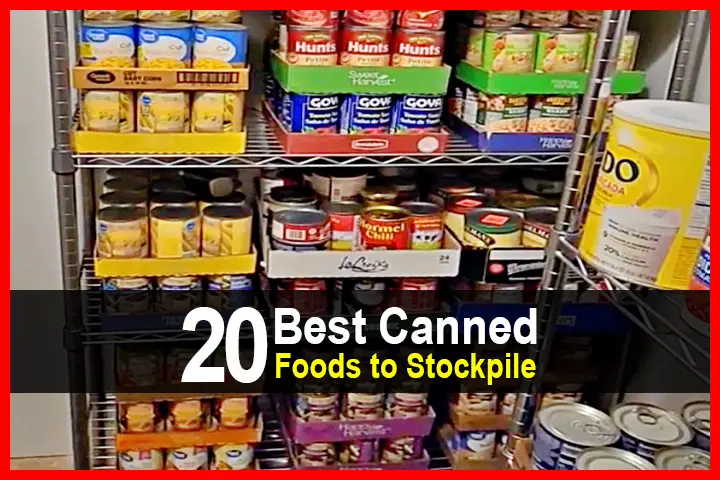Estimated reading time: 9 minutes
I want to start off by pointing out that you’re better off canning and/or dehydrating fruits, meats, and vegetables. Foods preserved at home are cheaper and healthier than store-bought canned foods.
Having said that, if you’re new to prepping and don’t know much about food preservation, or if you’re just looking to add more variety to your food stockpile, canned foods are an excellent option because they’re very easy to store and they have a very long shelf life, sometimes lasting for decades.
But which canned foods should you store? Here’s our list of recommendations.
Want to save this post for later? Click Here to Pin It On Pinterest!
1. Apples
I was going to mention applesauce, but it doesn’t normally come in cans. Besides, it’s better to get canned apples because you can use them as they are, or you can just mash them into applesauce.
Sweet foods are far outnumbered by savory ones when you’re limited to canned products, so canned apples are a great way to satisfy your sweet tooth while also getting most of the nutrients offered by a fresh apple.
2. Bacon
Yes, you read that correctly – bacon is available in a can!
If you are looking for a way to add delicious flavor to a wide variety of dishes while also increasing the amount of protein and calories that they provide, you can’t go wrong with canned bacon.
Best of all, canned bacon has a shelf life of over ten years, making it an excellent product to stock up on.
3. Baked Beans
What kind of prepper doesn’t have canned beans? Baked beans make for a great side dish, or they can be used as an addition to a number of recipes such as chilis, stews, and soups.
They’re also high in protein and fiber and are quite affordable as well.
4. Beef Stew
If you want to stock up on beef stew, you’ll have all kinds of options to choose from. There are many types of beef stew with most containing a number of vegetables as well.
The result is a filling meal high in protein and fiber that can also be added to rice and pasta to make for an easy dish.
5. Bread
Bread will likely be one of the most difficult food items to acquire in a survival scenario given that making it fresh requires a lot of different ingredients as well as some pretty serious baking skills.
Thankfully, B&M offers a product called canned brown bread which serves as a decent substitute. It’s not the best tasting bread and it isn’t exactly something you could use to make a sandwich, but it does go well with beans and other foods.
6. Chicken
If you’re unable to raise your own chickens, storing cans of chunk chicken breast is the next best thing. Canned chunk chicken breast contains diced chicken breast that is pre-cooked and packed in water, meaning that it is ready to eat right out of the can.
You can use the chicken breast in any recipe that calls for diced chicken or add it to salads and sandwiches. You can also use the water that has soaked up the chicken flavor as chicken broth.
7. Chili
If you want a ready-to-eat meal right out of the can, canned chili is a great option. Canned chili comes in a wide variety of flavors with an equally wide variety of ingredients, and it can also be enjoyed as an addition to dishes such as pasta and rice.
Most importantly, chili is a high-calorie meal and a great source of fiber and protein.
8. Corn
Corn is one of the best foods you can stockpile. You can use it in countless recipes, or you can eat it by itself.
Plus, it’s high in calories, and pretty much everybody likes it. This is one instance where you’re definitely better off buying the canned version instead of buying it fresh and preserving it yourself.
9. Creamed Corn
Creamed corn is a delightful deviation from the regular kernel corn. Its creamy texture and inherent sweetness make it an excellent addition to casseroles, soups, or as a standalone side dish. It can also be a versatile ingredient for creating comfort foods during trying times.
10. Diced Tomatoes
So many recipes are tomato-based that canned tomatoes are an essential supply to stock up on.
If you buy diced tomatoes instead of tomato sauce or tomato paste, though, you can easily use a blender to turn them into any type of canned tomato product that you need.
11. Green Beans
Growing fresh vegetables in a survival garden is always an ideal solution. However, certain times of the year you may not have any fresh vegetables available, even if you are able to successfully grow a garden.
To supplement your garden veggies, stock up on canned vegetables such as canned green beans which are high in nutrients and can be eaten as a side dish or added to a number of soups and casseroles.
12. Ham
For those who fancy a variation from the typical canned bacon and Spam, canned ham emerges as a robust contender. It provides an excellent source of protein and can be utilized in sandwiches, omelets, or even stews. The salty richness of ham can enhance a variety of dishes, making it a versatile meat option to have on hand.
13. Mandarin Oranges
In those moments when you’re seeking a refreshing bite amidst the more savory canned options, mandarin oranges offer a delightful solution. They can be enjoyed straight out of the can, incorporated into salads, or even baked into pastries. Rich in Vitamin C, they’re not just a tasty treat but a boost to your immune system, essential in times of survival.
14. Olives
Whether it’s green or black varieties, olives offer a distinct flavor profile that can elevate a dish. They can be tossed in salads, used as pizza toppings, or eaten as is. Rich in healthy fats and essential nutrients like Vitamin E, they are both delicious and beneficial.
15. Pie Filling
If canned applesauce isn’t quite enough to satisfy your cravings for sweet foods, you can stock up on canned pie filling as well. Even if you don’t have the ingredients necessary to bake a pie, simply heating up the pie filling and eating it by itself can make for a tasty treat.
Pie filling might not be as nutritious as most of the foods in your stockpile, but it is high in calories and can serve as a guilty pleasure at a time when such pleasures may be few and far between.
16. Pineapple Chunks
For a tropical twist, consider stocking up on canned pineapple chunks. The natural enzymes present in pineapple can aid in digestion, and its sweet, tangy flavor is a welcome change from the conventional canned fruits. They can be integrated into fruit salads, grilled for an added smoky flavor, or used in savory dishes to offer a contrast in taste.
17. Soup
Especially chicken noodle soup. There’s a reason why chicken noodle soup is a go-to favorite for people who are feeling under the weather. This soup is hearty, warming, and full of easy-to-digest energy to get you back up on your feet.
Add cans of chicken noodle soup to your survival stockpile to enjoy regardless of whether you’re feeling sickly or not.
18. Spam
Spam may have somewhat of a poor reputation, but you may be surprised to learn that it’s actually made of a lot higher quality meat than other processed meats such as hot dogs. Rather than being made from meat by-products, spam is produced using ham and chopped pork shoulder.
Spam is also high in protein, calories, and fats, and it can be used as a substitution for other meat in most dishes such as stews, pastas, and chilis.
19. Tuna
Tuna makes for an excellent source of fatty acids and protein and is especially high in nutrients if you get tuna that is packed in oil rather than water (as an important bonus, tuna packed in oil keeps for a longer period of time as well).
Canned tuna can be used in a wide number of recipes such as soups and pastas, added to salads and sandwiches, or eaten straight out of the can.
20. Vegetable Medley
Speaking of supplementing fresh vegetables with canned vegetables, stocking up on cans of vegetable medley will allow you to enjoy a variety of vegetables such as corn, carrots, green beans, lima beans, and others all in a single product.
It makes for a great side dish that offers a range of nutrients given all of the different vegetables that it contains.
How to Get the Most Out of Your Canned Foods
Knowing which foods to buy is only the first step. The next step is figuring out how to properly store your food. Most canned foods have a great shelf-life. However, you can extend the shelf-life even further by storing them in a cool, dark location.
Even if you store your cans in an ideal location, it’s still important to watch out for signs of spoilage. When canned foods do spoil, the results are nothing to mess around with. Botulism – one common form of canned food spoilage – can actually lead to death.
Suffice it to say that one bad can could easily ruin your entire survival plan, causing a few miserable days at best and costing you your life at worst.
To further prevent spoilage, get in the habit of rotating your food storage. For example, if a can has a shelf-life of five years and you’ve been storing it for four years, take it out and eat it now and then replace it with a fresh can. That way, you’re always keeping your stockpile fresh for when disaster strikes.
How you label your canned food is another important consideration. While the canned food you buy will likely be labeled well-enough the day it’s bought, the food inside the may very well outlast the label on the outside.
Over time, labels can fade or peel off, making it impossible to distinguish what’s inside that blank aluminum. As a backup plan, you may want to add a strip of masking tape to the top of each can and write down what’s inside it on the tape using a permanent marker, along with the date.
Lastly, be sure to add plenty of can openers to your stockpile as well. Can openers do break or stop working sometimes, so it’s a good idea to have plenty of them around.
While opening a can with a knife is possible, it’s not nearly as easy as they make it out to be in the movies. If a knife is all that you have available, you’ll likely end up cutting yourself, making a big mess, or both, so do yourself a favor and keep some extra can openers tucked away.
Living off of canned foods alone is not ideal and not particularly good for your health (due to all the sodium). However, it is something you could do temporarily if necessary and it’s not nearly as unenjoyable as it might sound.
While you’ll still want to supplement your canned food with fresh food every chance you get, having a stockpile of canned food to rely on can certainly keep you from going hungry.
Like this post? Don’t Forget to Pin It On Pinterest!


















